| Travel, Science, Mountains and Oceans | ||||||||||||||||
 |
||||||||||||||||


At the early stages of formation, the Earth appeared as a cold body in space, containing all of the chemical elements known in Nature. The atmosphere and hydrosphere did not yet exist; the surface of the planet was completely lifeless. But gradually, due to gravitational forces, energy released by the breakdown of radioactive elements and lunar tides deep inside the core of the Earth began to heat up. When temperatures near the core of the Earth reached that level where the melting of iron oxides and other compounds could occur, the active processes began for the formation of a nucleus and the main environment of the planet.
The general process of formation of the Earth's environment, was through zoned melting in the mantle, situated around a nucleus. Thus the dense, and heaviest sank toward the centre, increasing the size of the nucleus, and less dense and lighter elements rose to the surface, forming the lithosphere, the top-most part of which is the Earth's crust. These processes caused the onset of great volcanic activity over all areas on the surface of the Earth and produced great and extensive outpourings of basaltic lava, releasing gases and water vapour. Gravity forces kept the gases and water vapour in the near-earth proximity, and these formed a primitive, proto-atmosphere, but deprived of oxygen.
By radiating heat into Space, the Earth's surface gradually cooled. The water vapours (gas) condensed, and became liquid water. Active elements and compounds, discharged from still more volcanic activity, interacted with the water, forming acids and salts.
It is probable that such processes occurred on the
Earth's surface and deep within the core of the Earth as well, between about 4 billion
years ago billion years ago . 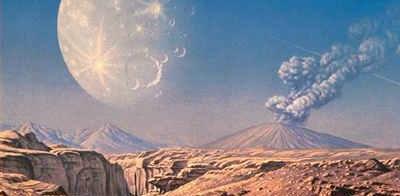
Deep tectonic processes and the heterogeneous nature of the earth's crust are not uniform. Therefore, raised areas with thickened but chemically lighter crust have developed into land masses, and sunken areas with heavier crust have become the sea floor, covered by water. The availability of an atmosphere, a planetary water-cycle, and seasonal and daily changes of temperature above the surface of the sea promoted the development of processes of weathering, erosion and mass-wasting. The products of mass-wasting and erosion accumulated at the bottoms of basins and reservoirs, forming the layers (strata) of sedimentary rocks. A continuous cycle of formation and destruction of parts of the earth's surface occurred, causing a constant change in the morphology of the mountains, plains and seas.
Redistribution of mantle materials within the Earth
and their rise to the surface and above caused the development of the atmosphere and
hydrosphere. The duration of these processes was all throughout the geological history of
the planet and is still going on today. The weight of the water on the surface and in the
oceans gradually increased, having formed a
There are various points of view regarding the origin and development of continents and oceans, some of which sometimes contradict each another:
According to one of these points of view, the bottom of the oceans represents primary basalt from the earth's crust, and the continents were formed later as a result of the accumulation of very great thicknesses of sedimentary rocks which were deposited in great, shallow ocean basins, which, because of the great weight, became compressed into folds, forming folded mountain systems.
Another hypothesis assumes that modern ocean basins (or their parts) occurred in areas where earlier, huge continents partially collapsed, compressing these materials into the basins and transforming them from "continental" into "oceanic" deposits, during a cycle called "oceanisation."
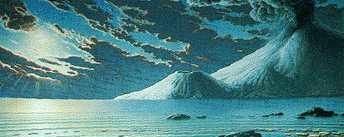
There is another hypothesis which shows that the Earth has expanded over long periods, during which time, the area of the bottom of the oceans between the continents began moving apart. The distance between these continents increased, and the water, earlier only the lower parts of continents, completely flowed into the ocean basins.
The hypothesis of horizontal movements of lithospheric plates is the most widely accepted today. According to this hypothesis, the uppermost part of the Earth - the lithosphere - is joined by a number of adjacent, rigid plates, under which the effects of convection currents in the mantle cause these plates to move relative to one-another.
Where the plates diverge due to spreading, there is an upwelling of mantle material into the crust in the rifted area. As this hot mantle material (magma) rises, it cools and crystallises. As more magma upwells into the rift zone, it pushes the crystallised material upward and away from the rift zones, causing mid-ocean ridges to form. Moreover, the iron minerals in the magma take the exact properties of the Earth's magnetic field at the time that these minerals crystallise, and are sometimes used in geophysical measurements. You will learn more about this process later.
Where these plates converge upon each other, one of
the plates is pushed downward beneath the other plate. This is called
"subduction" and occurs at all convergent plate boundaries. As the one
subducting plate is being pushed down, the other plate rides up and over the downward
moving plate. Very deep trenches are formed in these subduction zones (for example, the
Kurile Islands Trench), and just behind them, island arcs (such as the
Along the edges and borders of plate divergence and convergence, because of the active tectonic processes beneath them, high seismicity and intensive volcanic activity occurs. The movement of the plates have resulted in continental drift, closing and opening of oceans, but the water of the ocean remained, flowing from one depression to another.
What is the practical value of the study of these geological processes? The knowledge of the history of the formation of the Earth permits us to understand the formation of useful minerals which have come to us from deep within the core of the Earth. By tracing the different continents and oceans, geological structures and borders of lithosphere plates, scientists can reconstruct their previously adjoining areas, and predict the formation of petroleum and other exploitable minerals and ores. They can also try to predict disastrous earthquakes and other natural hazardous phenomena.
Main lithosphere plates
The arrows show the directions of movement of the
lithosphere plates moved by convection currents in the mantle.
Intensity of plate movement:
1.Direction of plate movement
2.At spreading
3.At subduction
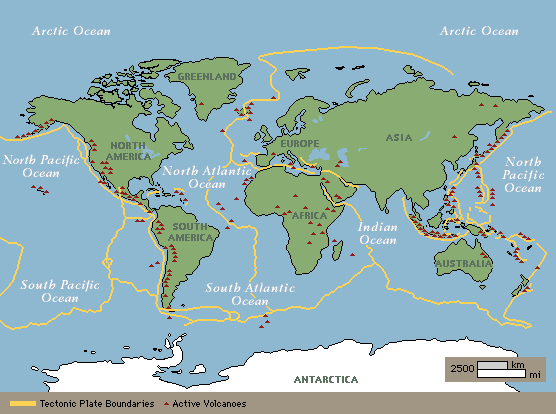
INTERNAL MECHANICS OF LITHOSPHERIC PLATE MOVEMENT
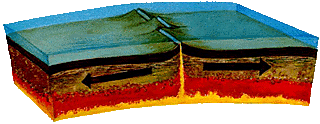
The constant rise of mantle material (magma) along an axis of a mid - oceanic ridge causes divergence of lithosphere plates.
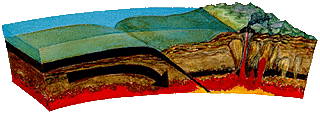
Collision of oceanic and continental plates. The subducting of an oceanic plate under a continental plate creates a deep trench adjacent to the continental coast and a great mountain range on land.
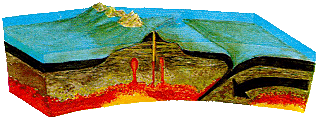
Down-drag
of an oceanic plate in the mantle results in the formation of an volcanic island-arc
system in the ocean and deep trench seaward of the island-arc.
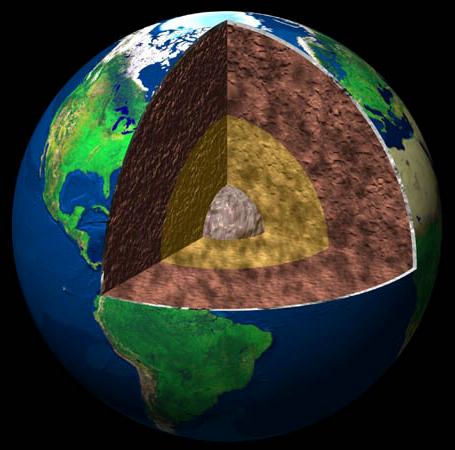
Earths
Cross section
Earth's crust
Oceans
Mantle
Outer-core
Inner-core
Hadean
This
era begins with the formation of the Solar System and Earth, outgassing of first
atmosphere and oceans, bombardment by left-over planetessimals and debris. The name says
it all; a hellish period lasting some 760 million years, when the Earth was subject to
frequent bombardment by comets, asteroids, and other planetary debris. At one point, early
in this era the moon was formed when a Mars-sized body struck the original Earth,
pulverizing both. Yet incredibly, the first primitive life emerged even at this early
stage. This was an era characterized by extensive volcanism and formation of first
continents. By the end of the Hadean, the Earth had an atmosphere (unbreathable to most
organisms today), and oceans filled with prokaryote life evolution
The
name Hadean was coined by geologist Preston Cloud for the pre-Isuan sequence whose record
may not be preserved on Earth but is better known from Moon rocks
During
Hadean time, the Earth and Solar System formed by coagulation and gravitation contraction
from a large cloud of gas and dust around the sun, called an accretion disc. The sun
formed the nucleus, shrinking in on itself by gravitational compaction until it reached a
stage where it ignited with nuclear fusion and give off light and heat. The surrounding
particles within this cloud coalesced into planetisimals which then aggregated to form
microplanets (rather like modern asteroids). The energy of the collisions between
the larger microplanets, as well as interior radioactive and gravitational heating,
generated a huge amount of heat, and the Earth and other planets would have been initially
molten. The Earth and Moon formed from a collision between two previous
planets - a mars-sized and a slightly larger one.
During
this period the heavier molten iron sank to the down to become the core, whilst the
lighter rocks rose to the surface, the lightest of all becoming the crust as a sort of
"scum" on the surface. There was also an outgassing of volatile molecules
such as water, methane, ammonia, hydrogen, nitrogen, and carbon dioxide. An
initial steam atmosphere was made of water from comets and hydrated minerals. Rain
fell into proto-ocean 4.3 to 4.4 billion years ago. All terrestrial planets had a
similar process in their early histories.
Once
most of the planetisimals were gone the planetary bombardment stopped, and a stable rocky
crust was able to formed on the Earth. This is the age of the oldest rocks on earth
and also of moon-rocks. Atmospheric water condensed into oceans and proto-life
formed in the soup of primordial organic molecules, either in the early oceans or in clay
or rocks within the crust itself.
Archean
Lasting
more than twice as long as the Phanerozoic eon, the Archean was a time when diverse
microbial life flourished in the primordial oceans, and the continental shields developed
from volcanic activity. The reducing (anaerobic) atmosphere enabled archea (anaerobic
microbes) to develop, and plate tectonics followed a regime of continental drift different
to that of the Proterozoic and later. During this era, one type of organism, the
Cyanobacteria (blue-green algae) produced oxygen as a metabolic by-product; the eventual
build-up of this highly reactive gas was to eventually prove fatal to many life-forms, and
converted the atmosphere from.
The
Origin of the Continents
Rocks
of the Lower Archean (in geology time is often referred to vertically, because
younger rocks are deposited above older ones) are rare, and include the oldest known
terrestrial rocks, from
This
general period, from about
The
Origin of Life
The
appearance of life on Earth was preceded by a period of chemical evolution, whereby the
relative simple organic molecules gradually aggregated together to form larger and more
complex macro-molecules, and finally the first life itself. Scientists claim
to be able to repeat all these stages in their laboratories, but doubts have been
expressed occasionally.
We do
not know when life first appeared on Earth. The oldest fossil microorganisms are as
old as the oldest sedimentary rocks. So we can assume that life has been around as
long as conditions have been suitable.
The
beginning of life on Earth was also the birth of "Gaia" as a dynamic entity.
When we examine the Earth as a whole, we realize that Gaia itself does not
include the entire planet, but only a thin film on the surface of the globe. It is
this crust, or rather, the surface of this crust, along with the oceans (hydrosphere),
atmosphere, soil (lithosphere), and living organisms (biosphere), which constitutes
"Gaia".
At
the time of these first organisms there was no free oxygen, as there is now, but rather a
"reducing atmosphere" composed of methane, carbon dioxide, and hydrogen.
The Earth's atmosphere then was thus not very different to the present
atmosphere of Venus or Jupiter.
The
microorganisms of this period utilized methane or hydrogen rather than oxygen in their
metabolism - they are therefore referred to as "anaerobic"
(non-oxygen-using). Fermentation is modern example of anaerobic metabolism.
This type of metabolism is 30 to 50 times less effective than
oxygen-based ("aerobic") metabolism, or respiration.
The
first organisms were "heterotrophs"; they derived their food from other
organisms or organic matter which they were able to consume. Very soon all the
available organic matter was exhausted, and life would have cannibalized itself to
extinction, were it not for the appearance of a new type of organism, capable of
manufacturing its own food, the "autotroph".
What
these autotrophs did was the greatest miracle our world has seen. They fed on
sunlight, on pure energy. Without them, the continuation of life would have been
impossible. They are still with us now. We call them "green
plants". These very early green plants were actually an extremely primitive
form of algae, similar to modern Blue-Green Algae.
Not
all of the single-celled organisms of this time were solitary. Beginning
around 3 billion years ago, and much more often from 2.3 billion years ago,
Blue-green Algae would often grow in large mats, called Stromatolites.
Modern-day Stromatolites can still be found in a sheltered bay in
The
fact that such organisms have survived to the present day gives some idea of how slow
their evolution is. The transformation of the biosphere seemed to be as slow as the
transformation of the geosphere.
The
Proterozoic
The
Proterozoic, which lasted even longer than the Archean Era, saw the atmosphere changes
from reducing to oxygenated, driving the original anaerobic inhabitants of the Earth into
a few restricted anoxic refuges and enabling the rise of aerobic life (both prokaryote and
the more complex eukaryotic cell, which requires the high octane boost that oxygen
enables.) Stromatolites (colonial cyanobacteria), which had appeared during the Archean,
were common. The modern regime of continental drift began, and saw the formation of
supercontinent of Rodinia, and several extensive ice ages. Late in the Proterozoic a
runaway icehouse effect meant that the preceding warm conditions were replaced by a
"Snowball Earth" with ice several kilometers deep covering the globe. Warming
conditions saw the short-lived Edicarian biota and finally the appearance of first
metazoa.
Paleozoic
Early
in the 300 million year history of the Paleozoic, atmospheric oxygen reached its present
levels, generating the ozone shield that screens out ultraviolet radiation and allows
complex life to live in the shallows and finally on land. This era witnessed the age of invertebrates,
of fish, of tetrapodomorphs,
and (during the Permian) reptiles.
From the Silurian on, life
emerged from the sea to colonize the land, and in the later Paleozoic pteridophyte and
later gymnospermous plants flourished. The generally mild to tropical conditions with
their warm shallow seas were interspersed with Ordovician and
Permo-Carboniferous ice
ages. Towards the end of the Paleozoic the continents clustered into the supercontinent of
Pangea, and
increasingly aridity meant the end of the great Carboniferous swamps and their unique
flora and fauna. The Paleozoic was brought to an end by the end Permian
mass-extinction, perhaps the most severe extinction the planet has seen.
The
Paleozoic (also spelt "Palaeozoic") era lasted from about 540 to 250 million
years ago, and is divided into six periods The 320-odd million years of the Paleozoic era
saw many important events, including the development of most invertebrate
groups, life's conquest of land, the evolution of fish, reptiles, insects,
and vascular plants, the formation of the supercontinent of Pangea, and no
less than two distinct ice ages. The earth rotated faster than it does today so days
were shorter, and the nearer moon meant stronger tides.
Continents
The
early Paleozoic saw the continents clustered around the equator, with Gondwanaland
(representing the bulk of old Rodinia) slowly
drifting south to the poles, and
It
seems that Gondwanaland underwent a large clockwise rotation around an axis close to
Baltica
joined with Laurentia during the Silurian, drifting
from a moderate southern hemisphere position in Cambro-Ordovician time to an equatorial
position in Silurian-Devonian time.
During
the middle and late Paleozoic (Devonian to Permian),
about a third of the Gondwanan mass was torn apart and drifted to equatorial regions. Most
of these blocks were assembled by a series of plate collisions into the supercontinent of Euramerica
(Laurussia) by the Devonian, which by addition of further landmasses became Laurasia
by the late Carboniferous.
Gondwana,
rotated clockwise and moved northward to collide with Laurasia. By Permian time, Siberia
and the
Climate
The
early Paleozoic was cool, culminating in the great Ordovician ice age. The Silurian saw
tropical climes and warm shallow seas filled with coral reefs. During the late
Paleozoic the temperature dipped again and the Permo-Carboniferous ice age meant that most
of the great southern continent of Gondwanaland was under heavy ice sheets.
Life
- the Biosphere
Life
changed so much during the Paleozoic - from seaweed to forests, from proto-chordates to
mammal-like synapsids - that
it is difficult to summarize. Although Paleozoic means "ancient
life" many of the organisms that lived during the later Paleozoic were much closer to
those of today than many of the life-forms of the early Paleozoic. Basically, at the
risk of generalization, we might say that the earlier Paleozoic was dominated by invertebrates,
while the land remained barren. The middle Paleozoic saw the rise of strange
armoured fish and the first land plants
and insects. While the later Paleozoic was distinguished by great forests of mostly
spore-bearing trees, inhabited by a rich assortment of arthropods, tetrapodomorphs
and reptiles
on land; and by diverse invertebrates in the sea.
Ecosystems
Cambrian eco-systems
were much simpler and less diversified than anything of today, and hence unstable and
prone to easy mass-extinction. Moreover, it is possible to distinguish an earlier
Tommotian type fauna (early Cambrian)
from a middle Cambrian to Early Ordovician
fauna.
Following
the large end-Cambrian and end-early Ordovician extinctions, a new evolutionary fauna
originated and diversified during the Ordovician
radiation event. This constituted a Palaeozoic marine benthos
associated with soft substrates. Articulate brachiopods,
stenolaemate bryozoans, stalked echinoderms (crinoids and blastoids), corals, ostracodes
all diversified. Higher up in the water column, the plankton and nekton
included graptolites and conodonts, cephalopods, and
later fish and medusa (scyphozoa). This vigorous early Ordovician radiation set the agenda
for much of the Palaeozoic; and most adaptations by the various invertebrate
groups had already been tried and tested by the end of the Ordovician. By the Middle to
Late Paleozoic marine eco-systems may not have been too unlike those of today.
Ecosystems and energy and nutrient flow on land was much
more inefficient, until the rise of reptilian herbivores at the very end of the era (late Permian).
Intelligence
Perhaps
the most intelligent creatures to inhabit the earth over this long span of time were the cephalopods, the
most intelligent and sentient of all the invertebrates. Cephalopods were
extraordinarily diverse in Paleozoic seas, and were the dominant life-form until the rise
of carnivorous fish during the Devonian
(mid-Paleozoic). At the very end of the Paleozoic the Therapsida evolved
larger brains than their contemporaries, and paved the way for mammalian intelligence
during the Mesozoic and Cenozoic.
Mass
extinctions
The
Paleozoic witnessed a number of crises in the history of life, including an early
Cambrian, a terminal Cambrian, an Ordovician one, a late Devonian one.
The era was brought to an end by the terminal Permian extinction,
the greatest catastrophe in the history of higher life on Earth (although far milder than
the Early Proterozoic Oxygen crisis), not counting the present ongoing biocide of life at
the hands of man. There is still disagreement over whether it was caused simply by
terrestrial phenomena like loss of geographic isolation and falling sea-levels, or whether
(as I feel likely) these factors were aided by an extraterrestrial impact of some kind
(similar to the one that saw off the dinosaurs at the
end of the Mesozoic).
Mesozoic
Lasting
little more than half the duration of the Paleozoic, this was a spectacular time. The
generalized archosaurian reptiles of the Triassic gave way to the dinosaurs, a terrestrial
megafauna the like of which the Earth has not seen before or since. While dinosaurs
dominated the land, diverse sea-reptiles ruled the oceans, and invertebrates, especially
ammonites, were extremely diverse. Pterosaurs and later birds took to the
sky. Mammals however remained small and insignificant. Climatic conditions remained warm
and tropical worldwide. The supercontinent of Pangea broke up into Laurasia and Gondwana,
with different dinosaurian faunas evolving on each. During this era modern forms of
corals, insects, fish and finally flowering plants evolved. At the end of the Cretaceous
period the dinosaurs and many other animals abruptly died out, quite likely the result of
an asteroid impact and associated extensive volcanism (acid rain)
The
Mesozoic Era lasted more than 180 million years. During this time, many modern forms
of plants, invertebrates, and fishes evolved. On land, dinosaurs were the
dominant animals, while the oceans were populated by large marine reptiles, and Pterosaurs ruled
the air. For most of this period, the climate worldwide was warm and tropical, and
shallow seas covered lowlying landmasses. At the beginning of the Mesozoic,
all of the world's continents were joined into the supercontinent of Pangea, which
rifted into Laurasia in the
north and Gondwanaland in the
south. By the end of the era most of continents had separated into their present
form.
The
Mesozoic Era is divided into three periods, each lasting many millions of years: the Triassic, Jurassic, and Cretaceous.
The Triassic saw the emergence of many modern invertebrate groups, and on land the archosaur reptiles
replaced the therapsids.
In the oceans Ichthyosaurs such
as Shonisaurus became
as large as whales. The Jurassic was the
height of the dinosaur era, with giants such as Brachiosaurus, Stegosaurus, etc,
and mammals tiny and
shrew-like. Distinctive plants like ferns, Cycads, Bennettitales, and Cheirolepidiaceae
conifers characterised the landscape. During the Cretaceous period,
the first flowering plants appeared, birds and fish
diversified, and new types of dinosaurs appeared. The climate cooled and unique
dinosaurs evolved on different continents.
The
Mesozoic era came to an end with the great terminal extinction event known as the K-T
(Cretaceous-Tertriary) event.
Cenozoic
With
the extinction of the dinosaurs and the end of the Mesozoic, the mammals swiftly inherit
the Earth. Archaic mammals co-existed with birds and modern reptiles and
invertebrates. The current continents emerged, and the initial tropical conditions were
replaced by a colder drier climate, possibly caused by the Himalayan uplift. The
appearance of grass meant the rise of grazing mammals, and the cooler drier world allowed
modern mammalian groups to evolve, along with other lineages now extinct and a few archaic
hold-overs. Among the newcomers were the anthropoid apes
that culminated in the australopithecine hominids of
During
the 65 million years of the Cenozoic era (also spelt "Cainozoic") or Age of
Mammals the world took on its modern form. Invertebrates,
fish, reptiles etc were
essentially of modern types, but mammals, birds, protozoa and
flowering plants still evolved and developed during this period.
The
Cenozoic Era is divided into two very unequal periods, the Tertiary (which
made up the bulk of the Cenozoic), and the Quaternary, which
is only the last one and a half million years or so. The Tertiary is in turn divided
into Paleogene and Neogene.
Geosphere
During
the Cenozoic the fragmentation of continental landmasses continued as the Earth's surface
took on it's present form. Beginning in the Late Cretaceous rifts separated
Climate
During
the Paleogene the
climate worldwide was warm and tropical, much as it had been for most of the preceding
Mesozoic. The Neogene saw a
drastic cooling in the world's climate, possibly caused by the Himalayan uplift (Tibetan
plateau) that was generated by the Indian subcontinent ramming into the rest of Asia (and
is still going on now). During the Quaternary period
the continuing cooling climate resulted in an ice age, or rather a series of ice ages with
interspersed warm periods
Biosphere
The Paleogene saw the
diversification of many mammalian and bird groups, flourishing in the tropical conditions.
During the early Paleogene the continents were isolated by shallow seas, and
different lineages of Mammals evolved on
each one. Mammals included many giant yet small-brained rhinoceros-like types - the
Asiamerican uintatheres, and
brontotheres and the African arsinoitheres. There were huge flightless
carnivorous birds - the Laurasian diatrymids (left) and the South American phorusrhacids -
2 meters tall with cruel curved beaks, that mimicked the great theropod dinosaurs
of the Mesozoic. All these animals lived in tropical forests. The champsosaurs,
crocodile-like "eosuchian" reptiles - living
fossils of their time - survived the dinosaurs and the K-T extinction but died out later
in the Paleogene. In the seas the first archaic toothed whales appeared. Giant
marine protozoa, (foraminifers) the size of lentils evolved during the Eocene. Bivalve and Gastropod molluscs
were basically the same type as today. The nautilids experienced their last
mild evolutionary radiation. Transitional forms ancestral to modern coleoid cephalopods
evolved. Echinoderms, corals, bryozoa and sponges were
basically of modern type. On land insects were generally of modern type.
Ants were even more numerous then they are today.
During
the Neogene modern
mammals and flowering plants evolve, as well as many strange mammals that are no longer
around. The most astonishing thing to happen during the early Neogene was the
evolution of grass. This led to the evolution of long-legged running animals adapted
to life on the savanna and prairie. The horse family - Equiidae - was an especial
success story during the Neogene. Horses and other grazing mammals evolved
high-crowned teeth to cope with a diet of abrasive grass. There were still many
forest animals however. The Mastodons lived on every continent except
The
Quaternary period saw essentially modern flora and invertebrate species. However
many mammalian types were of species and genera now extinct, and generally of large size -
the various species of mammoth, the Irish "elk" (left), a large diversity of
rhinos, the giant ground sloths, the diprotodonts of Australia, and many more.
Man evolved as an ice-age mammal in
Intelligence
Unlike
the previous eras of life, the Cenozoic was characterized by a progressive increase of
intelligence - an intelligence arms race compared to the "brawn" arms race of
Mesozoic (to give a simplistic but perhaps apt generalization).
The Paleogene saw an
abundance of small-brained "archaic" mammals. Even though Paleogene
carnivores had consistently larger brains than Paleogene herbivores, both had much smaller
brains then later mammals. Obviously, plant eaters had to evolve bigger brains to
cope with the meat-eaters, and the meat-eaters had to evolve bigger brains again to
out-smart the plant-eaters. By the Neogene larger
brained mammals of essentially the same intelligence as modern forms appeared.
But the most intelligent animals of this time were the forest dwelling
monkeys and early anthropoid apes on
land, and essentially modern cetaceans in the seas. One lineage of apes came down
from the trees, perhaps due to population pressures and increasing aridification, and
began to explore the African grasslands. These were the hominids. During
the Quaternary the
hominids took up using tools, and their was an exponential increase in their brain
capacity, a sort of feedback loop stimulated by tool-using and gestural proto-language.
The result was the evolution of Man and the birth and exponential
acceleration of the Teilhardian Noosphere, a
process that began with the discovery of language and tools and is still continuing
Ocean
issues are not receiving the attention they ought to be given." The ocean is a
resource that is less well known than some distant planets and undoubtedly contains a
resource potential that remains partly untapped. But this resource is limited, both in
capacity and in its ability to absorb the effects of reckless development and pollution.
Signs of stress are already visible, especially in low-lying coastal areas and small
islands. The picture of the ocean that is emerging from shared observations all over the
world is not very comforting. The catalogue of symptoms of disease include: pollution,
exhausted fishing stocks, disappearing coastlines, rising sea level, increasing surface
temperatures that threaten the deep ocean currents, more frequent storms, melting ice
caps... When we understand the ocean system better, we will be able to predict some of the
changes expected in the next century and, hopefully, offset them through intelligent,
co-operative action. In the shorter term, better and more systematic observations of the
ocean will enable us to forecast imminent disasters from storms, floods and drought and
mitigate their effects, by warning the populations at risk.



Waves rise as mountains
And rise to the heavens,
And with horror drops glances
Into instantly dug abysses
A disturbing force like passion,
Does not know of a centre point,
Now to the sky, now into the precipice throws
A boat without an oar or rudder. A.K. Tolstoy

Sign Guestbook View Guestbook
|